Checking Out the Czech Republic
Prague and Karlovy Vary, August 25-30
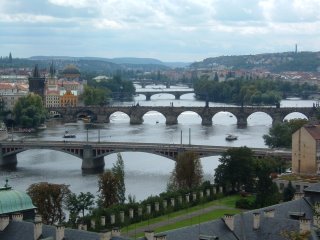
Prague bridges over Vltava River
Prague has long been known as “The Golden City,” but when Todd last visited in 1963, the place looked like the stage set for a pre-war Hitchcock spy movie. Boy, how things have changed! The fantastic architecture, representing more than seven centuries of genius, now gleams with fresh paint and gilt, and the streets pulse with commerce generated above all by legions of foreign tourists.
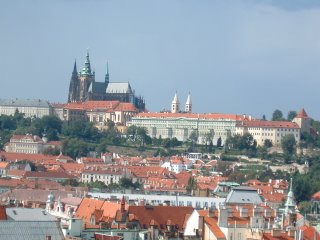
Prague Castle
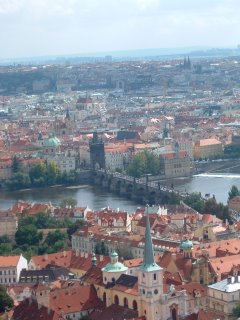
Charles Bridge, Prague
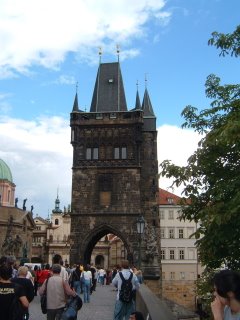
Charles Bridge Tower, Prague
The building that encapsulates Prague for us is St. Vitus’s Cathedral in the Castle, begun in the 10th Century but finished in the 20th, with both impressive Gothic towers and magnificent Art Nouveau stained glass windows. Yet, like most visitors we were also attracted by the astronomical clock on the Old Town Hall, where a skeleton pulls a chain to sound the hour. Standing in the huge square in front of the town hall, we could see both the monument to Jan Hus, the proto-Protestant reformer-martyr and Czech national hero, and the huge Gothic Church of the Virgin Mary before Tyn, restored to Catholicism after the Habsburgs finally subdued the Hussites in the Thirty Years War. Czech history is neither simple nor happy.
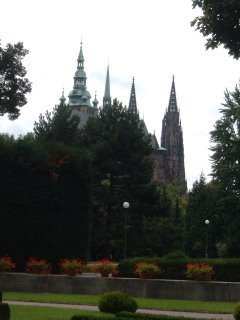
St. Vitus Cathedral towers from the Belvedere, Prague
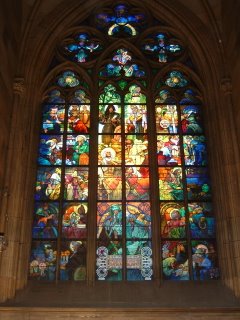
Art Nouveau stained glass window by Alfons Mucha in St. Vitus Cathedral, Prague
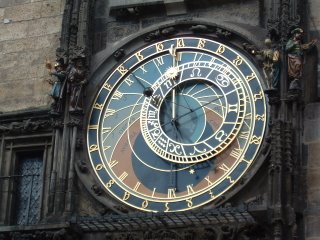
Astronomical clock, Stare Mesto, Prague
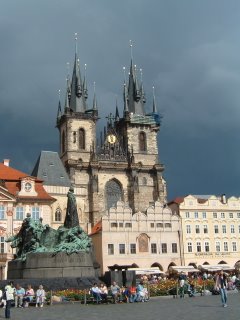
Church of the Virgin Mary before Tyn and Jan Hus memorial, Prague
One Habsburg who gets goods reviews in Prague is Emperor Joseph II, who relaxed restrictions on Jews and had the city’s Jewish quarter, the Josefov, named after him as a result. We spent a morning touring the area’s synagogues, some working and others museums with a wealth of Jewish art from Bohemia and Moravia. Particularly memorable was the Old Jewish Cemetery, which was so limited in size that the deceased had to be interred on top of each other; the visible gravestones are only a fraction of those buried below. Chillingly, the Nazis kept the synagogues, the art and the cemetery intact to serve as exhibits in a museum they planned to depict a vanished race.
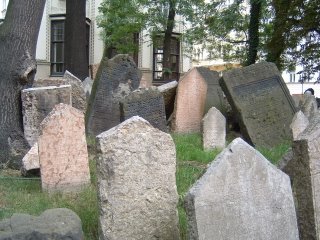
Old Jewish Cemetery, Prague
The crush of tourists was sometimes claustrophobic, but we were happy to find uncrowded restaurants that offered excellent Czech food, beer and wine (the last a welcome surprise) at reasonable prices. On our way back from one dinner, we strolled down Wenceslas Square past the statue of the warrior-saint himself, whom we English-speakers sing about every Christmas. This square was the scene of huge demonstrations we remember from television in 1968 and, more happily, in 1989.

Wenceslas Square, Prague
Our only negative in the Czech Republic was the weather, a continuation of the successive periods of sun and rain that had dogged us ever since Lviv. We could escape indoors in Prague, but there was no refuge from a heavy shower as we climbed 2 km from the parking lot to Karlstejn Castle south of Prague. We nonetheless enjoyed this paradigmatic fortress, built by Emperor Charles IV in the 14th Century along with the Charles Bridge, Charles University in Prague and the spa of Karlovy Vary (Carlsbad), which was our next destination for a two-night stay.
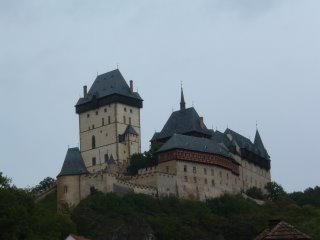
Karlstejn Castle
Located some 120 km west of Prague, Carlsbad was long Europe’s premier location to take the waters as a cure for various ailments. Visitors ranged from Peter the Great, Goethe, and Edward VII to--amazingly—Karl Marx, who wrote some of “Das Kapital” there. (Perhaps he wanted to observe the class struggle up front and personal; in any event he came in three successive years.) Today Karlovy Vary is an outstandingly beautiful place with its Victorian and Edwardian grandeur restored. The healing waters still gush forth so we bought spouted drinking cups to sample the effluent from springs registering 30, 50, 63, and 72 degrees Celsius—all reasonably potable. If the two of us radiate health when we next meet, you will know our secret.
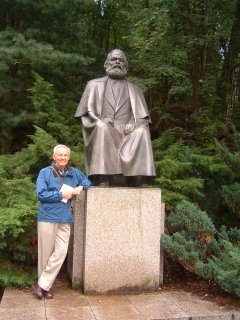
Best buddies (Todd and Karl)

Karlovy Vary at Mill Colonnade

Taking the waters, Karlovy Vary
As in the past, Karlovy Vary is very multi-national with a wealth of languages spoken on the street. We were initially surprised by the amount of Russian we heard, but we learned that wealthy Russians had been coming since the late 19th Century. Certain hotels and spas cater to a Russian-speaking clientele while ours was filled with German golfers attracted by the area’s reportedly excellent courses. Native English-speakers were definitely a small minority although English is widely used as a lingua franca. In short, we strongly recommend that you pay a visit to Karlovy Vary—and bring your clubs.

0 Comments:
Post a Comment
<< Home